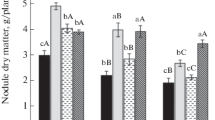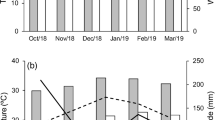Abstract
Harnessing the beneficial potential of plant growth-promoting rhizobacteria may be an alternative strategy to improve plant tolerance to drought stress. The effect of inoculation with Bradyrhizobium japonicum and Azospirillum brasilense either alone or in combination on the plant growth and drought tolerance of soybean [Glycine max (L.) Merrill.] was investigated in this study in greenhouse conditions. Treatments were arranged in a randomized block design in a 3 × 4 factorial: three irrigation regimes [100% of pot capacity—PC (well-watered control), 50% of PC (moderate stress) and 25% of PC (severe stress)] and four inoculation treatments [control (non-inoculated), inoculation with B. japonicum, inoculation with A. brasilense, and co-inoculation with B. japonicum and A. brasilense]. Leaf relative water content, cell membrane stability, root nodulation, plant growth, and morphophysiological indexes were recorded. The inoculation of soybean plants with B. japonicum and A.brasilense either alone or in combination improved leaf membrane stability under drought stress conditions when compared to non-inoculated plants; however, this lower damage to cell membranes was not sufficient to maintain the leaf water content of the plant under drought stress. Plants co-inoculated with B. japonicum and A.brasilense improved the root nodulation under severe drought conditions. Inoculation of B. japonicum and A. brasilense either alone or in combination reduced the pod abortion rate under moderate drought stress, but had no effect under severe drought stress. In summary, the co-inoculation of A. brasilense and B. japonicum alleviate adverse effects limited by drought stress to the growth of soybeans.Author: Please check and confirm that the authors [Elijanara Raissa Silva, Carlos Eduardo Silva Oliveira, Alan Mario Zuffo, Eduardo Pradi Vendruscolo] and their initials have been correctly identified and amend if necessary.The authors were correctly identified.


Similar content being viewed by others
References
Abbasi S, Zahedi H, Sadeghipour O, Akbari R (2013) Effect of plant growth promoting rhizobacteria (PGPR) on physiological parameters and nitrogen content of soybean grown under different irrigation regimes. Res Crops 14:798–803
Agami RA, Medani RA, Abd El-Mola IA, Taha RS (2016) Exogenous application with plant growth promoting rhizobacteria (PGPR) or proline induces stress tolerance in basil plants (Ocimum basilicum L.) exposed to water stress. Int J Agric Environ Res 5:78–92
Arzanesh MH, Alikhani HA, Khavazi K, Rahimian HA, Miransari M (2011) Wheat (Triticum aestivum L.) growth enhancement by Azospirillum sp. under drought stress. World J Microbiol Biotechnol 27:197–205
Assaha DV, Liu L, Ueda A, Nagaoka T, Saneoka H (2016) Effects of drought stress on growth, solute accumulation and membrane stability of leafy vegetable, huckleberry (Solanum scabrum Mill.). J Environ Biol 37:107–114
Bai Y, Zhou-**ao M, Smith DL (2003) Enhanced soybean plant growth resulting from coinoculation of Bacillus strains with Bradyrhizobium japonicum. Crop Sci 43:1774–1781
Benincasa MPM (2003) Análise de crescimento de plantas: noções básicas. FUNEP, Jaboticabal, p 42
Benintende S, Uhrich W, Herrera M, Gangge F, Sterren M, Benintende M (2010) Comparación entre coinoculación con Bradyrhizobium japonicum y Azospirillum brasilense e inoculación simple con Bradyrhizobium japonicum en la nodulación, crecimiento y acumulación de N en el cultivo de soja. Agriscientia 37:71–77
Bulegon LG, Rampim L, Klein J, Kestring D, Guimarães VF, Battistus AG, Inagaki AM (2016) Componentes de produção e produtividade da cultura da soja submetida à inoculação de Bradyrhizobium e Azospirillum. Terra Latinoam 34:169–176
Bulegon LG, Guimarães VF, Klein J, Batisttus AG, Inagaki AM, Offmann LC, Souza AKP (2017) Enzymatic activity, gas exchange and production of soybean co-inoculated with Bradyrhizobium japonicum and Azospirillum brasilense. Aust J Crop Sci 11:888–896
Casaroli D, Lier QJ (2008) Critérios para determinação da capacidade de vaso. Rev Bras Ciênc Solo 32:59–66
Cassán F, Perrig D, Sgroy V, Masciarelli O, Penna C, Luna V (2009) Azospirillum brasilense Az39 and Bradyrhizobium japonicum E109, inoculated singly or in combination, promote seed germination and early seedling growth in corn (Zea mays L.) and soybean (Glycine max L.). Eur J Soil Biol 45:28–35
Cerezini P, Kuwano BH, Santos MB, Terassi F, Hungria M, Nogueira MA (2016) Strategies to promote early nodulation in soybean under drought. Field Crops Res 196:160–167
Chibeba AM, Guimarães MF, Brito OR, Nogueira MA, Araujo RS, Hungria M (2015) Co-inoculation of soybean with Bradyrhizobium and Azospirillum promotes early nodulation. Am J Plant Sci 6:1641–1649
Curá JA, Franz DR, Filosofía JE, Balestrasse KB, Burgueño LE (2017) Inoculation with Azospirillum sp. and Herbaspirillum sp. bacteria increases the tolerance of maize to drought stress. Microorganisms 5:41
Embrapa (1997) Empresa Brasileira de Pesquisa Agropecuária. Manual de métodos de análise de solo, 2. edn. EMBRAPA/CNPS, Rio de Janeiro, p 212
Fipke GM, Conceição GM, Grando LF, Teleken L, Nunes RL, Ubirajara R, Martin TN (2016) Co-inoculation with diazotrophic bacteria in soybeans associated to urea topdressing. Ciênc Agrotec 40:522–533
German MA, Burdman S, Okon Y, Kigel J (2000) Effects of Azospirillum brasilense on root morphology of common bean (Phaseolus vulgaris L.) under different water regimes. Biol Fertil Soil 32:259–264
Gray SB, Brady SM (2016) Plant developmental responses to climate change. Dev Biol 419:64–77
Gusain YS, Singh US, Sharma AK (2015) Bacterial mediated amelioration of drought stress in drought tolerant and susceptible cultivars of rice (Oryza sativa L.). Afr J Biotechnol 14:764–773
Hungria M, Mendes IC (2015) Nitrogen fixation with soybean: the perfect symbiosis? In: Bruijn FJ (ed) Biological nitrogen fixations. Wiley, Ney Jersey, pp 1009–1021
Hungria M, Nogueira MA, Araujo RS (2015) Soybean seed co-inoculation with Bradyrhizobium spp. and Azospirillum brasilense: a new biotechnological tool to improve yield and sustainability. Am J Plant Sci 6:811–817
Inagaki AM, Guimarães VF, Rodrigues LFOS, Silva MB, Diamante MS, Rampim L, Mioranza TM, Duarte Júnior JB (2014) Phosphorus fertilization associated to inoculation of maize with diazotrophic bacteria. Afr J Agric Res 9:3480–3487
Juge C, Prévost D, Bertrand A, Bipfubusa M, Chalifour FP (2012) Growth and biochemical responses of soybean to double and triple microbial associations with Bradyrhizobium, Azospirillum and arbuscular mycorrhizae. Appl Soil Ecol 61:147–157
Liu F, **ng S, Ma H, Du Z, Ma B (2013) Cytokinin producing, plant growth promoting rhizobacteria that confer resistance to drought stress in Platycladus orientalis container seedlings. Appl Microbiol Biotechnol 97:9155–9164
Lutts S, Kinet JM, Bouharmont J (1996) Effects of salt stress on growth, mineral nutrition and proline accumulation in relation to osmotic adjustment in rice (Oryza sativa L.) cultivars differing in salinity resistance. J Plant Growth Regul 19:207–218
Mantovani D, Veste M, Boldt-Burisch K, Fritsch S, Koning LA, Freese D (2015) Carbon allocation, nodulation, and biological nitrogen fixation of black locust (Robinia pseudoacacia L.) under soil water limitation. Ann For Sci 58:259–274
Marks BB, Megías M, Nogueira MA, Hungria M (2013) Biotechnological potential of rhizobial metabolites to enhance the performance of Bradyrhizobium japonicum and Azospirillum brasilense inoculants with the soybean and maize crops. Appl Microbiol Biotechnol 3:1–10
Mertz-Henning LM, Ferreira LC, Henning FA, Mandarino JMG, Santos ED, Oliveira MCND, Nepomuceno AEL, Farias JRB, Neumaier N (2018) Effect of water deficit-induced at vegetative and reproductive stages on protein and oil content in soybean grains. Agronomy 8:1–11
Naveed M, Hussain MB, Zahir ZA, Mitter B, Sessitsch A (2014) Drought stress amelioration in wheat through inoculation with Burkholderia phytofirmans strain PsJN. Plant Growth Regul 73:121–131
Pinheiro C, Chaves MM (2011) Photosynthesis and drought: can we make metabolic connections from available data? J Exp Bot 62:869–882
Potters G, Pasternak TP, Guisez Y, Palme KJ, Jansen MAK (2007) Stress-induced morphogenic responses: growing out of trouble? Trends Plant Sci 12:98–105
Sangtarash MH (2010) Responses of different wheat genotypes to drought stress applied at different growth stages. Pak J Biol Sci 13:114–119
Vieira EA, Silva MG, Moro CF, Laura VA (2017) Physiological and biochemical changes attenuate the effects of drought on the Cerrado species Vatairea macrocarpa (Benth.) Ducke. Plant Physiol Biochem 115:472–483
Vurukonda SSKP, Vardharajula S, Shrivastava M, Skz A (2016) Enhancement of drought stress tolerance in crops by plant growth promoting rhizobacteria. Microbiol Res 184:13–24
Wellstein C, Poschlod P, Gohlke A, Chelli S, Campetella G, Rosbakh S, Canullo R, Kreyling J, Jentsch A, Beierkuhnlein C (2017) Effects of extreme drought on specific leaf area of grassland species: a meta-analysis of experimental studies in temperate and sub-Mediterranean systems. Glob Change Biol 23:2473–2481
Xu Z, Zhou G, Shimizu H (2010) Plant responses to drought and rewatering. Plant Signal Behav 5:649–654
Zoz T, Steiner F, Guimarães VF, Castagnara DD, Meinerz CC, Fey R (2013) Peroxidase activity as an indicator of water deficit tolerance in soybean cultivars. Biosci J 29:1664–1671
Zuffo AM, Bruzi AT, Rezende PM, Bianchi MC, Zambiazzi EV, Soares IO, Ribeiro ABM, Vilela GLD (2016) Morphoagronomic and productive traits of RR soybean due to inoculation via Azospirillum brasilense groove. Afr J Microbiol Res 10:438–444
Acknowledgements
To CNPq (National Council for Scientific and Technological Development) and UEMS (State University of Mato Grosso do Sul) for the scientific initiation scholarship granted to the second author.
Author information
Authors and Affiliations
Contributions
ERS, JA, AMZ, and FA designed and carried out the experiment. ERS, JZ, FS, and AMZ collected the data. FS and AMZ performed the analysis. ERS, JZ, CESO, and AMZ contributed to the interpretation of the results. FA wrote the manuscript. TZ and EPV contributed to the final version of the manuscript. All authors provided critical feedback and helped to shape the research, analysis, and manuscript.
Corresponding author
Additional information
Communicated by Erko Stackebrandt.
Publisher’s Note
Springer Nature remains neutral with regard to jurisdictional claims in published maps and institutional affiliations.
Rights and permissions
About this article
Cite this article
Silva, E.R., Zoz, J., Oliveira, C.E.S. et al. Can co-inoculation of Bradyrhizobium and Azospirillum alleviate adverse effects of drought stress on soybean (Glycine max L. Merrill.)?. Arch Microbiol 201, 325–335 (2019). https://doi.org/10.1007/s00203-018-01617-5
Received:
Revised:
Accepted:
Published:
Issue Date:
DOI: https://doi.org/10.1007/s00203-018-01617-5




